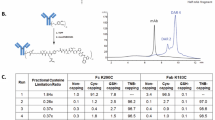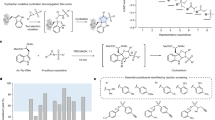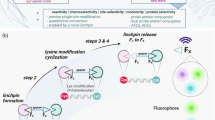Abstract
Site-selective functionalization of complex molecules is one of the most significant challenges in chemistry. Typically, protecting groups or catalysts must be used to enable the selective modification of one site among many that are similarly reactive, and general strategies that selectively tune the local chemical environment around a target site are rare. Here, we show a four-amino-acid sequence (Phe-Cys-Pro-Phe), which we call the ‘π-clamp’, that tunes the reactivity of its cysteine thiol for site-selective conjugation with perfluoroaromatic reagents. We use the π-clamp to selectively modify one cysteine site in proteins containing multiple endogenous cysteine residues. These examples include antibodies and cysteine-based enzymes that would be difficult to modify selectively using standard cysteine-based methods. Antibodies modified using the π-clamp retained binding affinity to their targets, enabling the synthesis of site-specific antibody–drug conjugates for selective killing of HER2-positive breast cancer cells. The π-clamp is an unexpected approach to mediate site-selective chemistry and provides new avenues to modify biomolecules for research and therapeutics.
This is a preview of subscription content, access via your institution
Access options
Subscribe to this journal
Receive 12 print issues and online access
$259.00 per year
only $21.58 per issue
Buy this article
- Purchase on SpringerLink
- Instant access to full article PDF
Prices may be subject to local taxes which are calculated during checkout






Similar content being viewed by others
Accession codes
References
Carrico, I. S. Chemoselective modification of proteins: hitting the target. Chem. Soc. Rev. 37, 1423–1431 (2008).
Hackenberger, C. P. R. & Schwarzer, D. Chemoselective ligation and modification strategies for peptides and proteins. Angew. Chem. Int. Ed. 47, 10030–10074 (2008).
Rabuka, D. Chemoenzymatic methods for site-specific protein modification. Curr. Opin. Chem. Biol. 14, 790–796 (2010).
Spicer, C. D. & Davis, B. G. Selective chemical protein modification. Nature Commun. 5, 4740 (2014).
Editorial. Take aim. Nature Chem. 4, 955 (2012).
Panowski, S., Bhakta, S., Raab, H., Polakis, P. & Junutula, J. R. Site-specific antibody drug conjugates for cancer therapy. MAbs 6, 34–45 (2014).
Kochendoerfer, G. G. Site-specific polymer modification of therapeutic proteins. Curr. Opin. Chem. Biol. 9, 555–560 (2005).
Uttamapinant, C. et al. A fluorophore ligase for site-specific protein labeling inside living cells. Proc. Natl Acad. Sci. USA 107, 10914–10919 (2010).
Krishna, O. D. & Kiick, K. L. Protein- and peptide-modified synthetic polymeric biomaterials. Peptide Sci. 94, 32–48 (2010).
Lichtor, P. A. & Miller, S. J. Combinatorial evolution of site- and enantioselective catalysts for polyene epoxidation. Nature Chem. 4, 990–995 (2012).
Wilcock, B. C. et al. Electronic tuning of site-selectivity. Nature Chem. 4, 996–1003 (2012).
Sletten, E. M. & Bertozzi, C. R. Bioorthogonal chemistry: fishing for selectivity in a sea of functionality. Angew. Chem. Int. Ed. 48, 6974–6998 (2009).
Afagh, N. A. & Yudin, A. K. Chemoselectivity and the curious reactivity preferences of functional groups. Angew. Chem. Int. Ed. 49, 262–310 (2010).
Lewis, C. A. & Miller, S. J. Site-selective derivatization and remodeling of erythromycin A by using simple peptide-based chiral catalysts. Angew. Chem. Int. Ed. 45, 5616–5619 (2006).
Chen, M. S. & White, M. C. A predictably selective aliphatic C–H oxidation reaction for complex molecule synthesis. Science 318, 783–787 (2007).
Snyder, S. A., Gollner, A. & Chiriac, M. I. Regioselective reactions for programmable resveratrol oligomer synthesis. Nature 474, 461–466 (2011).
Pathak, T. P. & Miller, S. J. Site-selective bromination of vancomycin. J. Am. Chem. Soc. 134, 6120–6123 (2012).
Wender, P. A., Hilinski, M. K. & Mayweg, A. V. W. Late-stage intermolecular CH activation for lead diversification: a highly chemoselective oxyfunctionalization of the C-9 position of potent bryostatin analogues. Org. Lett. 7, 79–82 (2005).
Peddibhotla, S., Dang, Y., Liu, J. O. & Romo, D. Simultaneous arming and structure/activity studies of natural products employing O–H insertions: an expedient and versatile strategy for natural products-based chemical genetics. J. Am. Chem. Soc. 129, 12222–12231 (2007).
Saxon, E. & Bertozzi, C. R. Cell surface engineering by a modified Staudinger reaction. Science 287, 2007–2010 (2000).
Rostovtsev, V. V., Green, L. G., Fokin, V. V. & Sharpless, K. B. A stepwise Huisgen cycloaddition process: copper(I)-catalyzed regioselective ‘ligation’ of azides and terminal alkynes. Angew. Chem. Int. Ed. 41, 2596–2599 (2002).
Agard, N. J., Prescher, J. A. & Bertozzi, C. R. A strain-promoted [3+2] azide−alkyne cycloaddition for covalent modification of biomolecules in living systems. J. Am. Chem. Soc. 126, 15046–15047 (2004).
Song, W., Wang, Y., Qu, J. & Lin, Q. Selective functionalization of a genetically encoded alkene-containing protein via ‘photoclick chemistry’ in bacterial cells. J. Am. Chem. Soc. 130, 9654–9655 (2008).
Blackman, M. L., Royzen, M. & Fox, J. M. Tetrazine ligation: fast bioconjugation based on inverse-electron-demand Diels–Alder reactivity. J. Am. Chem. Soc. 130, 13518–13519 (2008).
Saxon, E., Armstrong, J. I. & Bertozzi, C. R. A ‘traceless’ Staudinger ligation for the chemoselective synthesis of amide bonds. Org. Lett. 2, 2141–2143 (2000).
Lin, C.-W. & Ting, A. Y. Transglutaminase-catalyzed site-specific conjugation of small-molecule probes to proteins in vitro and on the surface of living cells. J. Am. Chem. Soc. 128, 4542–4543 (2006).
Wollack, J. W., Silverman, J. M., Petzold, C. J., Mougous, J. D. & Distefano, M. D. A minimalist substrate for enzymatic peptide and protein conjugation. ChemBioChem 10, 2934–2943 (2009).
Yin, J. et al. Genetically encoded short peptide tag for versatile protein labeling by Sfp phosphopantetheinyl transferase. Proc. Natl Acad. Sci. USA 102, 15815–15820 (2005).
Cull, M. G. & Schatz, P. J. Biotinylation of proteins in vivo and in vitro using small peptide tags. Methods Enzymol. 326, 430–440 (2000).
Fernandez-Suarez, M. et al. Redirecting lipoic acid ligase for cell surface protein labeling with small-molecule probes. Nature Biotechnol. 25, 1483–1487 (2007).
Popp, M. W., Antos, J. M., Grotenbreg, G. M., Spooner, E. & Ploegh, H. L. Sortagging: a versatile method for protein labeling. Nature Chem. Biol. 3, 707–708 (2007).
Whitford, D. Proteins: Structure and Function (Wiley, 2005).
Walsh, C. Enabling the chemistry of life. Nature 409, 226–231 (2001).
Giles, N. M., Giles, G. I. & Jacob, C. Multiple roles of cysteine in biocatalysis. Biochem. Biophys. Res. Commun. 300, 1–4 (2003).
Weerapana, E. et al. Quantitative reactivity profiling predicts functional cysteines in proteomes. Nature 468, 790–795 (2010).
Nathani, R. I. et al. A novel approach to the site-selective dual labelling of a protein via chemoselective cysteine modification. Chem. Sci. 4, 3455–3458 (2013).
Chalker, J. M., Bernardes, G. J. L., Lin, Y. A. & Davis, B. G. Chemical modification of proteins at cysteine: opportunities in chemistry and biology. Chem. Asian J. 4, 630–640 (2009).
Hermanson, G. T. in Bioconjugate Techniques 3rd edn (ed Hermanson, G. T.) 1–125 (Academic, 2013).
Sun, M. M. C. et al. Reduction–alkylation strategies for the modification of specific monoclonal antibody disulfides. Bioconjug. Chem. 16, 1282–1290 (2005).
Griffin, B. A., Adams, S. R. & Tsien, R. Y. Specific covalent labeling of recombinant protein molecules inside live cells. Science 281, 269–272 (1998).
Adams, S. R. et al. New biarsenical ligands and tetracysteine motifs for protein labeling in vitro and in vivo: synthesis and biological applications. J. Am. Chem. Soc. 124, 6063–6076 (2002).
Wilson, P. et al. Organic arsenicals as efficient and highly specific linkers for protein/peptide–polymer conjugation. J. Am. Chem. Soc. 137, 4215–4222 (2015).
Stroffekova, K., Proenza, C. & Beam, K. G. The protein-labeling reagent FLASH-EDT2 binds not only to CCXXCC motifs but also non-specifically to endogenous cysteine-rich proteins. Pflügers Arch. 442, 859–866 (2001).
Gautier, A. et al. An engineered protein tag for multiprotein labeling in living cells. Chem. Biol. 15, 128–136 (2008).
Rush, J. S. & Bertozzi, C. R. New aldehyde tag sequences identified by screening formylglycine generating enzymes in vitro and in vivo. J. Am. Chem. Soc. 130, 12240–12241 (2008).
Spokoyny, A. M. et al. A perfluoroaryl-cysteine SNAr chemistry approach to unprotected peptide stapling. J. Am. Chem. Soc. 135, 5946–5949 (2013).
Zhang, C., Spokoyny, A. M., Zou, Y., Simon, M. D. & Pentelute, B. L. Enzymatic ‘click’ ligation: selective cysteine modification in polypeptides enabled by promiscuous glutathione S-transferase. Angew. Chem. Int. Ed. 52, 14001–14005 (2013).
Zhang, C., Dai, P., Spokoyny, A. M. & Pentelute, B. L. Enzyme-catalyzed macrocyclization of long unprotected peptides. Org. Lett. 16, 3652–3655 (2014).
Zou, Y. et al. Convergent diversity-oriented side-chain macrocyclization scan for unprotected polypeptides. Org. Biomol. Chem. 12, 566–573 (2014).
Sievers, E. L. & Senter, P. D. Antibody–drug conjugates in cancer therapy. Annu. Rev. Med. 64, 15–29 (2013).
Junutula, J. R. et al. Site-specific conjugation of a cytotoxic drug to an antibody improves the therapeutic index. Nature Biotechnol. 26, 925–932 (2008).
Junutula, J. R. et al. Rapid identification of reactive cysteine residues for site-specific labeling of antibody-Fabs. J. Immunol. Methods 332, 41–52 (2008).
Piccart-Gebhart, M. J. et al. Trastuzumab after adjuvant chemotherapy in HER2-positive breast cancer. N. Engl. J. Med. 353, 1659–1672 (2005).
Spangler, J. B., Manzari, M. T., Rosalia, E. K., Chen, T. F. & Wittrup, K. D. Triepitopic antibody fusions inhibit cetuximab-resistant BRAF and KRAS mutant tumors via EGFR signal repression. J. Mol. Biol. 422, 532–544 (2012).
Perrotte, P. et al. Anti-epidermal growth factor receptor antibody C225 inhibits angiogenesis in human transitional cell carcinoma growing orthotopically in nude mice. Clin. Cancer Res. 5, 257–265 (1999).
Artamkina, G. A., Egorov, M. P. & Beletskaya, I. P. Some aspects of anionic σ complexes. Chem. Rev. 82, 427–459 (1982).
Kolb, H. C., Finn, M. G. & Sharpless, K. B. Click chemistry: diverse chemical function from a few good reactions. Angew. Chem. Int. Ed. 40, 2004–2021 (2001).
Jewett, J. C. & Bertozzi, C. R. Cu-free click cycloaddition reactions in chemical biology. Chem. Soc. Rev. 39, 1272–1279 (2010).
Lang, K. & Chin, J. W. Cellular incorporation of unnatural amino acids and bioorthogonal labeling of proteins. Chem. Rev. 114, 4764–4806 (2014).
Acknowledgements
The authors thank S. Buchwald (Massachusetts Institute of Technology, MIT) and K. Dane Wittrup (MIT) for comments and suggestions regarding the manuscript. This work was supported by an MIT start-up fund, the National Institutes of Health (NIH; R01GM110535) and the Sontag Foundation Distinguished Scientist Award (to B.L.P.). C.Z. is a recipient of the George Büchi Research Fellowship, the Koch Graduate Fellowship in Cancer Research of MIT, and the Bristol-Myers Squibb Graduate Fellowship in Synthetic Organic Chemistry. M.W. is a National Science Foundation Graduate Research Fellow. The authors acknowledge the Biological Instrument Facility of MIT for providing the Octet BioLayer Interferometry System (NIH S10 OD016326), the MIT Center for Environmental Health Sciences (CEHS) Instrument Facility for providing the flow cytometer (P30-ES002109) and R.J. Collier (Harvard) for contributing laboratory equipment used in this study.
Author information
Authors and Affiliations
Contributions
C.Z. and B.L.P. conceived the work and designed the experiments. C.Z. performed the peptide and protein labelling experiments. M.W., T.Z. and T.V.H. performed the computational studies. N.J.Y. helped with antibody expression and purification. M.S.S. and C.Z. performed the flow cytometer and cell viability assays. C.Z. and B.L.P. wrote the manuscript, with input from all other authors.
Corresponding author
Ethics declarations
Competing interests
A patent application covering this work has been filed by MIT-TLO (US patent application no. 14/278060, International patent application no. PCT/US15/031082).
Supplementary information
Supplementary information
Supplementary information (PDF 4297 kb)
Rights and permissions
About this article
Cite this article
Zhang, C., Welborn, M., Zhu, T. et al. π-Clamp-mediated cysteine conjugation. Nature Chem 8, 120–128 (2016). https://doi.org/10.1038/nchem.2413
Received:
Accepted:
Published:
Issue date:
DOI: https://doi.org/10.1038/nchem.2413
This article is cited by
-
Homogeneous multi-payload antibody–drug conjugates
Nature Chemistry (2024)
-
Copper assisted sequence-specific chemical protein conjugation at a single backbone amide
Nature Communications (2023)
-
Site-selective chemical reactions by on-water surface sequential assembly
Nature Communications (2023)
-
Recent Advances in Bioorthogonal Ligation and Bioconjugation
Topics in Current Chemistry (2023)
-
Site-selective photocatalytic functionalization of peptides and proteins at selenocysteine
Nature Communications (2022)



